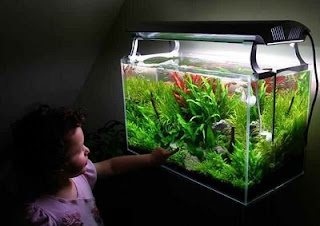CO2 Injection System in Planted Aquariums
 Carbon is the backbone of all life. Each organic molecule in every living organism predominantly carbon based. Given this simple fact, it becomes clear why the carbon dioxide (CO2) plays a key role in the planted aquarium. Aquatic plants extract CO2 from their environment and to employ in a process called photosynthesis. Photosynthesis combines CO2, water and light energy to produce simple carbohydrates and oxygen (O2).
Carbon is the backbone of all life. Each organic molecule in every living organism predominantly carbon based. Given this simple fact, it becomes clear why the carbon dioxide (CO2) plays a key role in the planted aquarium. Aquatic plants extract CO2 from their environment and to employ in a process called photosynthesis. Photosynthesis combines CO2, water and light energy to produce simple carbohydrates and oxygen (O2).The growth rates of aquatic plants are strongly dependent on the availability of carbon and plant affinity for carbon intake. Studies have shown that plants with the highest affinity for carbon were highest growth rates, while those with lower carbon affinity have adequate slower growth rates. Because carbon availability is usually the limiting factor for growth, addition of CO2 injection system to a planted aquarium will always result in large increases in growth (assuming other critical elements are missing).
At no additional CO2 growth rate will depend on the speed at which atmospheric CO2 equilibrates into the water. CO2 will dissolve in CO2 free water to a degree that depends on the content of the air pressure, temperature, pH and bicarbonate / carbonate from the water. The final concentration of CO2 in water depends entirely on those factors. Once that concentration is achieved, the level of CO2 will not change unless the plants remove it or one of the other factors is altered.
The plants remove CO2 at a rate significantly higher than the rate at which it equilibrates in water. Thus, the amount of CO2 usage, plant limits its growth using all the available CO2. Because CO2 is an integral part of the bicarbonate buffer system, the decline in CO2 will necessarily lead to an increase in pH. As the pH increases, the influx of additional atmospheric CO2 will be reduced by its conversion to bicarbonate.
This is offset somewhat by hard water plants that can utilize bicarbonate directly. However, without routine water changes or buffer additions (Alkaline Buffer™ or Liquid Alkaline Buffer™), this path will eventually lead to complete depletion of the KH (carbonate hardness) which will result in dramatic pH swings from day to night (5.7 - 9.6).
CO2 injection bypasses this predicament by delivering a constant source of CO2. Because the introduction of CO2 will lower pH, you have two options: (1) Monitor and calibrate the rate of CO2 addition to precisely match the usage by the plants or (2) use a pH feedback metering system, such as a pH controller. Option (2) is ideal because as the pH falls below a certain point, the CO2 turns off, thus avoiding catastrophic pH drops.
If you are not quite ready for the initial investment in a CO2 injection system but would still like to enjoy some of the benefits of adding additional carbon into your aquarium aquascapes, there is an alternative: Flourish Excel™. It provides a simple organic carbon molecule (similar to what is described above in the photosynthesis discussion) that plants can use as a building block for more complex carbohydrates. Because Flourish Excel™ is an organic carbon source, it does not impact pH. Even if you are already using CO2, you can still obtain a cumulative benefit by using Flourish Excel™ in conjunction with CO2.









